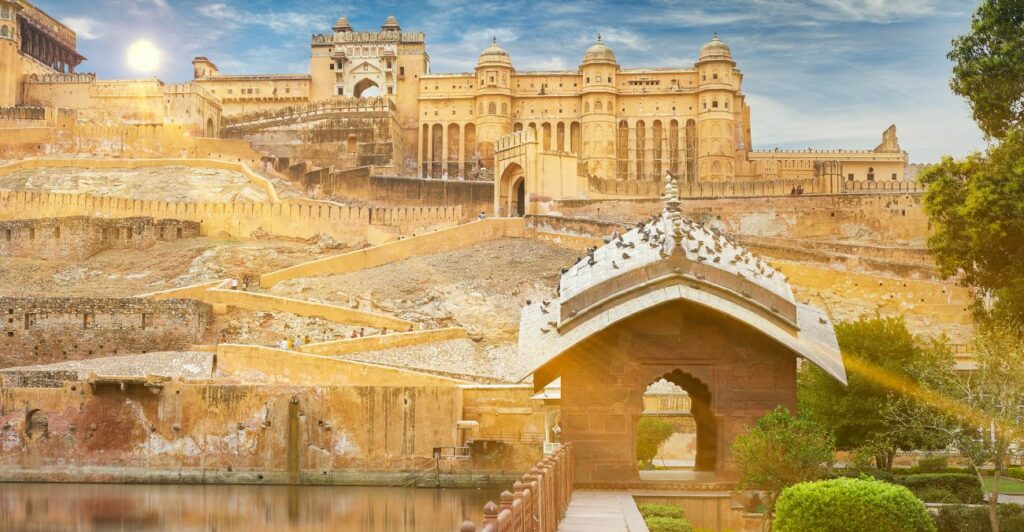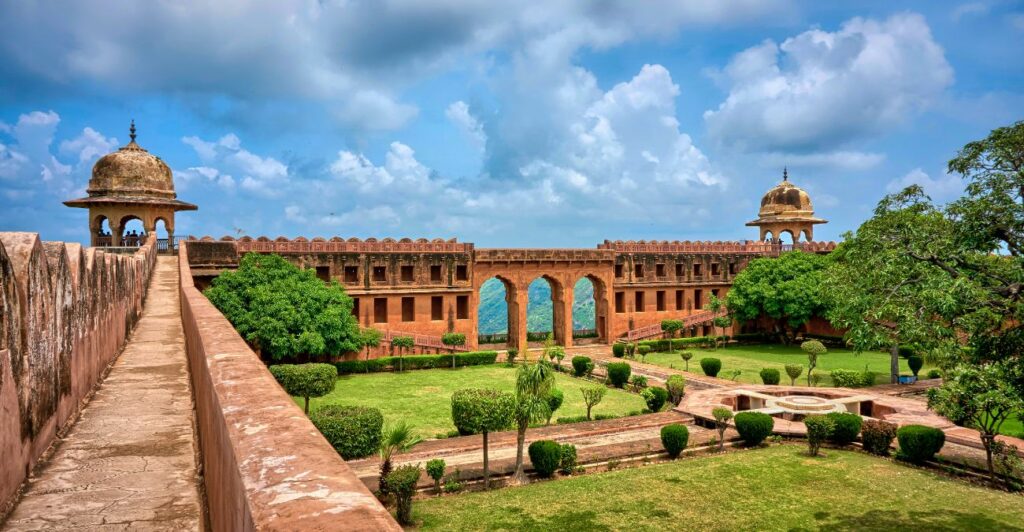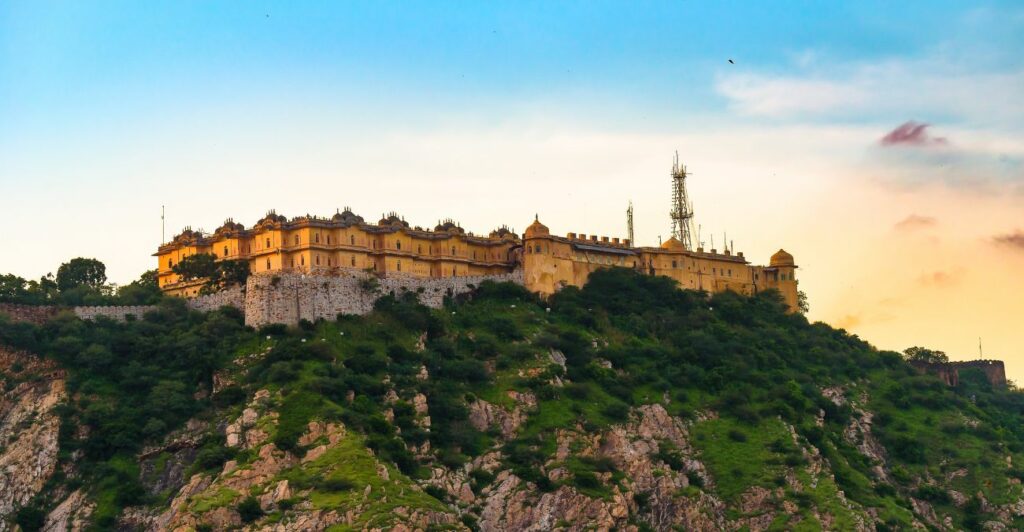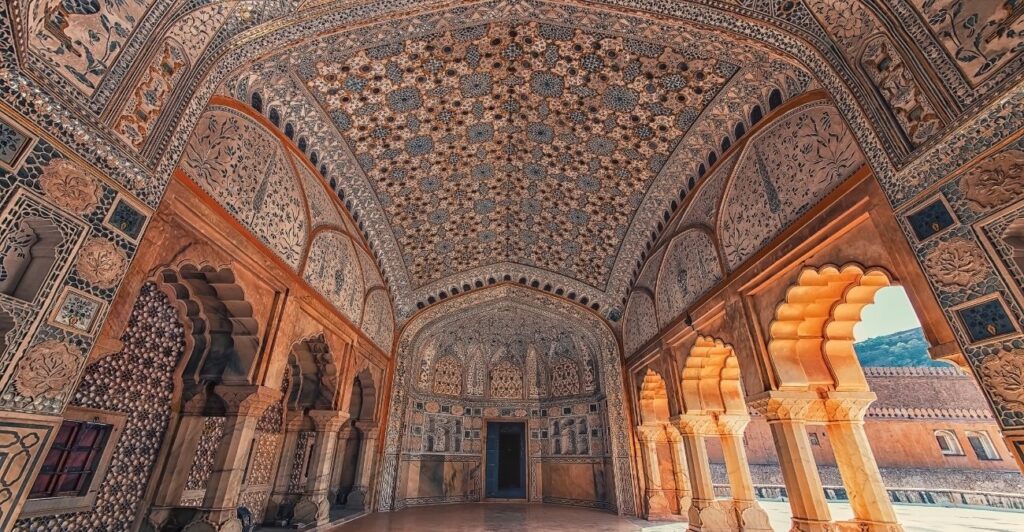Jaipur, the capital city of Rajasthan, is steeped in a rich history exemplified by its magnificent forts.
These grand structures testify to the city’s regal past, where they served as strongholds and centers of power and administration.
The forts around Jaipur have withstood the test of time and now stand as iconic landmarks, attracting tourists from all over the world to this destination fondly referred to as the ‘Pink City.’
Each fort in Jaipur tells a unique story of battles, architecture, and royal lifestyles. Built on hills and rugged terrains, they offer panoramic views of the city and the Aravalli ranges.
The elaborate design of these fortifications, with their towering walls and intricate details, showcase the expertise of the Rajput builders.
Their strategic locations, innovative defense systems, and magnificent decor play pivotal roles in narrating the saga of a bygone era.
Forts in Jaipur
| 1. Amer Fort |
| 2. Jaigarh Fort |
| 3. Nahargarh Fort |
1. Amer Fort: The Epitome of Rajputana Grandeur

Amer Fort, also widely known as Amber Fort, is an epitome of the Rajputana grandeur, with its foundation dating back to the late 16th century. Constructed by Raja Man Singh I in 1592, the fort is perched on a hill.
It commands a breathtaking view of Maota Lake, which provides a natural frontier to the sprawling fortification.
The fort’s strategic position on the hill also offered a vantage point for the rulers to observe any incoming threats, thereby serving a critical defensive purpose.
UNESCO World Heritage Status and Architectural Significance
The fort is recognized as a UNESCO World Heritage Site, a status it shares with other hill forts of Rajasthan, acknowledged for their historical and architectural significance.
The architecture of Amer Fort is a splendid amalgamation of Hindu and Mughal styles, an outcome of the Rajputs’ adeptness in forming alliances with the Mughals.
The use of pink sandstone and white marble in the fort’s construction adds a distinctive character to its appearance, with the pink hues symbolizing hospitality—a characteristic feature of the region’s architecture.
The Sheesh Mahal: A Mirror to History and Art
One of the most exquisite parts of the fort is the Sheesh Mahal, or Mirror Palace, built by King Man Singh in the 16th century and later completed by Mirza Raja Jai Singh.
The walls and ceiling of this palace are adorned with intricate mirror mosaics and colored glasses, a craft that originated in Persia and was brought to India by the Mughals.
The Sheesh Mahal’s construction was such that even a single candle flame would be reflected in the numerous mirrors and light up the entire room, creating a brilliant effect that mimicked a starlit sky.
Ethical Considerations: Elephant Rides to the Fort
The traditional elephant rides to the fort are reminiscent of the royal processions of the past, where the kings and queens would ascend the hill on these majestic animals.
However, it’s essential to note that these rides have become a subject of ethical scrutiny in recent years due to concerns over the welfare of the elephants.
Amer Fort and Jaipur: A Cultural Symbiosis
Amer Fort’s proximity to Jaipur, founded by Jai Singh II in 1727, makes it a prime tourist attraction. Jaipur’s rich cultural backdrop serves as a perfect complement to the historical allure of Amer Fort.
The city is a part of the Golden Triangle tourist circuit, along with Delhi and Agra, and contributes to the fort’s status as a must-visit destination for history enthusiasts and culture vultures.
The fort not only reflects the military history of the Rajputs but also serves as a significant cultural landmark.
2. Jaigarh Fort: The Fort of Victory

Jaigarh Fort, which stands majestically on the Cheel ka Teela (Hill of Eagles) of the Aravalli range, is a testament to the military architecture of Rajputana. Known as the ‘Fort of Victory,’ Jaigarh Fort is a symbol of the military prowess of the Rajputs and their strategic architectural sensibilities.
It was built in 1726 by Maharaja Sawai Jai Singh II, the ruler of Amber and the founder of Jaipur, primarily as a protective fort for the Amer Fort and as a stronghold to safeguard the region from attacking armies.
Architectural Significance
Constructed with thick walls of red sandstone, Jaigarh Fort reflects the practical aspect of military fortifications. Unlike other forts in the region, Jaigarh Fort lacks intricate interiors and focuses more on its defensive capabilities.
The fort’s strategic location offers commanding views of the surrounding landscape, making it an excellent observation post to keep an eye on any approaching adversaries.
The Jaivana Cannon
One of the most notable features of Jaigarh Fort is the Jaivana Cannon, which holds the record for being the world’s largest cannon on wheels.
Cast in 1720, the Jaivana Cannon was a showpiece of the foundry capabilities of the Rajputs and a symbol of their might. Despite its size and potential for destruction, the cannon was never used in battle.
Today, it remains a significant attraction for visitors, showcasing the advanced technology and metallurgical skills of the time.
The Fort as a Royal Treasury
Throughout its history, Jaigarh Fort has been closely associated with the royal family of Jaipur. It served a crucial role as a storage site for the war armory and a royal treasury where the spoils of war and royal riches were securely kept.
The fort’s robust design and isolated location made it an ideal choice for such a purpose, further emphasizing its importance beyond military functions.
Panoramic Vistas
The fort’s ramparts and walkways provide visitors with breathtaking panoramic views of the surrounding Aravalli Hills and the Amer Palace (Amber Fort) below.
The scenic beauty and the historical ambiance of Jaigarh Fort make it a photographer’s delight and a favorite among tourists seeking to experience the grandeur of Rajasthan’s regal past.
Connection to Amber Palace
Jaigarh Fort is connected to the Amber Palace (Amer Fort) through underground passages initially built for the royal family and the troops to escape in case of an invasion.
These passages underscore the strategic planning that went into fortifying the royal complexes and ensuring a quick and safe retreat if necessary.
Today, these passages are a point of intrigue for visitors, reflecting the meticulous defense strategies of the Rajput rulers.
Preservation and Tourism
As a historical monument, Jaigarh Fort is well-preserved, allowing visitors to explore its many features, including the water reservoirs, which were part of an efficient rainwater harvesting system.
The fort also houses a museum that displays a collection of weapons and armaments, photographs of the royal family, and other artifacts that provide insights into the fort’s past and the lifestyle of its inhabitants.
The fort’s expansive armory and museum also offer a glimpse into the ingenuity of the Rajput warfare tactics. The collection includes a variety of swords, shields, guns, and other weaponry used in battles fought by the Rajput warriors.
3. Nahargarh Fort: The Abode in the Clouds

Nahargarh Fort, whose name translates to ‘abode of tigers,’ is perched along the ridge of the Aravalli Hills, providing a majestic overlook of the bustling city of Jaipur.
The fort was initially named Sudarshangarh but later became known as Nahargarh.
It was built in 1734 by Maharaja Sawai Jai Singh II, the founder of Jaipur, as a retreat and part of the city’s defense system along with the Amer and Jaigarh forts.
Architectural Marvel
The architecture of Nahargarh Fort is a blend of Indian and European styles, which was quite common in the 18th century during the time of its construction.
The fort was later expanded in 1868 during the reign of Sawai Ram Singh II with new structures that further blended these architectural styles.
The Great Wall
One of the most striking features of Nahargarh Fort is the extended wall that connects it to Jaigarh Fort.
This wall was part of the defensive strategy for Jaipur and the nearby forts, and it is often compared to the Great Wall of China due to its length and the rugged terrain it traverses.
Today, this wall is a testament to the engineering skills of the past and offers a challenging trek for adventure enthusiasts.
Panoramic Views
Nahargarh Fort is renowned for its breathtaking views of the Pink City.
The fort’s vantage point on the Aravalli Hills allows visitors to capture the sprawling urban landscape of Jaipur, making it a popular spot for sunset and sunrise viewings.
The fort becomes even more enchanting at night when the city lights create a glittering spectacle below.
Sukh Niwas: The Summer Retreat
Within the fort complex lies Sukh Niwas, a summer retreat that exemplifies the ingenuity of ancient Indian architecture.
This palace was designed with small windows and an intricate water-cooling system that utilized the natural water flow to create a pleasant living environment during the scorching summer months.
The channels for water were so designed that they would cool the rooms as the breeze passed through them, an early form of air conditioning.
Preservation and Tourism
Nahargarh Fort has been well maintained, allowing visitors to experience its historical ambiance and architectural beauty. The fort houses a café that offers refreshments.
The fort houses a café that offers refreshments to visitors, allowing them to relax and soak in the panoramic views. Additionally, the fort complex includes a wax museum and a glass palace, adding to various tourist attractions.
The government and local authorities have taken measures to preserve the fort, ensuring its historical integrity remains intact while making it accessible and enjoyable for tourists.
Cultural Significance
Nahargarh Fort has also become a cultural hub in Jaipur, hosting various events such as art exhibitions, concerts, and festivals that attract locals and tourists.
It’s open courtyards and stunning backdrop make it an ideal location for such events, adding a layer of contemporary relevance to the historic site.
Key Attractions and Experiences

Jaipur’s forts are not just remnants of a bygone era but lively destinations teeming with cultural and aesthetic experiences.
Visitors can expect a blend of historical significance and spectacular sights demonstrated through majestic palaces, fascinating museums, and scenic views.
Majestic Palaces
Amer Palace, also known as Amber Palace, is a testament to Rajput grandeur’s harmonious blend of Hindu and Mughal architectures.
Tourists can explore the palace’s many halls, such as Sukh Niwas, where a historical climate control system illustrates the ingenuity of past craftsmen. The grandeur continues with Ganesh Pol, an imposing gateway adorned with intricate frescoes.
- Best Time to Visit: The cooler months from October to March provide a pleasant experience.
- Experiences: Guests can enjoy an elephant ride to the palace’s entrance or attend the mesmerizing light show in the evening.
Fascinating Museums
The forts of Jaipur include museums that display regal attire, armaments, and artifacts that narrate the city’s rich history. For instance, a museum within Amer Palace offers audio guides to enhance visitors’ understanding of the exhibits.
- Highlights: The Jaivana Cannon at Jaigarh Fort is recognized as the world’s largest cannon on wheels, representing the Rajput rulers’ military prowess.
- Tip: Utilize the audio guides for a more informed and immersive experience.
Scenic Views
The forts in Jaipur are strategically located, offering panoramic vistas of the surrounding landscape. The Sun Gate or Suraj Pol at Nahargarh Fort provides breathtaking sunrise and sunset views.
Visitors can also gaze upon Maota Lake, which reflects the stunning architecture of Amer Palace, or view the Palace of Winds and the Water Palace from various vantage points within the forts.
- Best Places for Views: The ramparts and towers of the forts and Nahargarh Fort are prime spots for scenic photographs.
- Additional Tip: Evening visits offer a beautiful transition from daylight to illuminated architecture, ideal for photography enthusiasts.
Cultural and Leisure Activities
The fusion of cultural practices and leisure pursuits in Jaipur reflects its rich heritage. Within the forts of this city, visitors can immerse themselves in activities that celebrate the past and present.
Local Traditions
At the heart of Jaipur, often referred to as the Pink City, the cultural tapestry weaves through the grandeur of its forts.
The Jai Mandir and the courtyards of Maharaja Sawai Man Singh II’s royal abode host traditional events and performances that echo the lifestyle of a bygone era. Spectators can view art forms preserved over centuries, such as folk dances and music, within the historic walls.
- Golden Triangle: Jaipur forms a part of this famous tourist circuit, and the forts encapsulate the quintessence of its rich culture.
- Magnificent Palaces: Visitors can experience living history through art exhibitions and cultural programs in these palatial venues.
Recreational Activities
Forts in Jaipur offer a variety of leisure activities for tourists and locals alike. These range from serene to adventurous, ensuring there is something for everyone.
- Main Entrance and Main Road: The approach to many Jaipur forts is an experience, with bustling bazaars reflective of street-level commerce and culture.
| Activity | Location | Description |
|---|---|---|
| Boat rides | Jal Mahal | Overlooking the beautiful water palace, visitors can enjoy tranquil boat rides on the lake. |
| Exploration | Panna Meena ka Kund | Near the Amer Fort, this stepwell is a place for those interested in ancient architecture and photography. |
| Shopping | Old City | The areas around the forts are brimming with local artisans and traders selling unique handicrafts and souvenirs. |
- Popular Tourist Attractions: Aside from their historical significance, Jaipur forts have become venues for various recreational pursuits, such as kite flying during festivals.
By visiting these emblematic structures, one enters a space where cultural activities honor the splendor of Jaipur’s past. At the same time, leisurely explorations offer a journey through the vibrant ethos of the city.
Travel Tips and Practical Information
When planning a visit to Jaipur’s historical forts and grand palaces, it’s essential to know the visiting hours, ticket information, accessibility, and means of transportation.
These details are vital to ensure a seamless and enjoyable experience at these popular tourist destinations.
Visiting Hours and Tickets
| Fort Name | Visiting Hours | Ticket Price (INR) | Note |
|---|---|---|---|
| Amber Fort (Fort of Victory) | 8:00 AM – 5:30 PM | Foreigners: 500, Indians: 100 | Elephant rides are available from 7:30 AM to 12:30 PM |
| City Palace | 9:30 AM – 5:00 PM | Foreigners: 700, Indians: 200 | Includes access to museums and galleries |
| Achrol Fort | 9:00 AM – 5:00 PM | Free | Less crowded, ideal for a quiet retreat |
- Amber Fort: Also known as the Victory Fort, was the stronghold of Raja Man Singh and features small windows designed for the royal women to observe court proceedings.
- City Palace: Built by Mirza Raja Jai Singh, this palace includes the Hall of Public Audience and houses a museum with rich artifacts.
Best Time to Visit: To avoid the summer heat and enjoy a pleasant tour, the best time to visit these forts is from October to March.
Getting There and Around
To Reach Jaipur:
- By Air: Jaipur International Airport is well-connected domestically and internationally.
- By Train: The main railway station in Jaipur links it to major Indian cities.
- By Road: Regular bus services and highways connect Jaipur to surrounding regions.
Local Transportation:
- Auto Rickshaws: A popular and affordable way to get around the city.
- Taxis: Available for hire for a more comfortable trip.
- Elephant Rides: Offered at Amber Fort, best booked in advance.
Key Locations:
- Amber Fort: Situated atop Cheel ka Teela (Hill of Eagles), an elephant ride or a short hike can reach it.
- City Palace: Located in the heart of Jaipur, easily accessible by local transport.
Best Way to Explore: The best way to explore and appreciate the architectural marvels of Jaipur is by hiring a local guide who can lead visitors through underground tunnels and elaborate courtyards like the Jaleb Chowk, providing historical context and sharing intriguing narratives.

Cory is a website owner and content creator who enjoys fishing, history, coin collecting, and sports, among other hobbies. He is a husband and father of four.
Romans 15:4 For whatever was written in former days was written for our instruction, that through endurance and through the encouragement of the Scriptures we might have hope.

